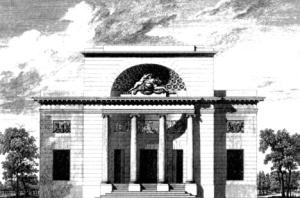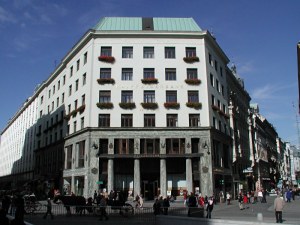By Geoffrey Yovanovic
I have always been fascinated by cities. While cities have always had a fundamental role in shaping culture, I was always more mesmerized by the towering skyscrapers and sinuous interstates which stretched to the horizon. The physical form of the city was what captured my imagination. I followed this natural interest into architecture where I focus primarily on traditional design. My interest in tradition has grown as I have been able to see past the aesthetic surface of a building and uncover the beauty and truth within the designs. Through my course on Pontifex, I hope to pass along these discoveries, and foster an appreciation of design that transcends the shock, sensation, and “originality” which passes for most architecture today.
My search for beauty started as an observation in my undergraduate architectural history survey course. I have always been interested in history so it was natural for me to create a timeline of major historical events and currents in the art world. It became clear to me that there would be a noticeable change in art during the decades preceding a cultural or political revolution. In France before the French Revolution, the architecture scraped off the barnacles of the Baroque and substituted a more rational Classical style. Prior to World War I in Europe, we find the introduction of International Style Modernism.

These observations remained as interesting but unrelated historical currents until I began research for my undergraduate thesis. I began studying whether architecture was used by the founding fathers to support their personal political beliefs. For example, was the Virginia Capitol designed by Thomas Jefferson as an aspiration to the ancient Roman Republic? It was. That was the easy question. Instead, my advisor challenged me to explore a deeper understanding of the Enlightenment ideas that influenced Jefferson’s architecture. He pressed me even further to look beyond the details and columns. He taught me to observe how the rational Enlightenment ideas about man’s relationship to the cosmos was subtlety transforming the shape and space created by their architecture. I first learned of beauty by recognizing its flight from Western art. And in this recognition, I discovered a fundamental culture shift away from the ideas of the Classical and Catholic world with its inherent embrace of beauty; towards an embrace of the rational and secular world of the Enlightenment.
Viewing this change in architecture from the 21st century is difficult. We see that the buildings of that era have columns. They are built of stone, not glass. They appear Classical to us. It is difficult for us to understand how Adolf Loos’ Looshaus in Vienna could have so insulted the sentiments of Emperor Franz Joseph that he would block the windows of his palace in order not to see the building. But, these buildings were only mile markers in the retreat from a Classical and Catholic view of the cosmos. We are surrounded and live amidst the yield of this Enlightenment world view.

I will begin to explore many of these themes in upcoming posts. By highlighting individual examples of buildings and cities, my hope is that I will be able to communicate the truths in the built environment that we all inhabit. Architecture is more than a style, and beauty is not captive to any specific style.
In my design work, I strive to recover what was discarded. Like the other artists with Pontifex University, I do not believe that simply returning to the past is a way to transform culture. I do believe that by learning the lessons of beauty and truth inherent in traditions we can advance our arts and culture. Originality has become an idol in art and architecture today. But while designing, I try to heed C.S. Lewis’ advice in the final paragraph of Mere Christianity:
“No man who bothers about originality will ever be original: whereas if you simply try to tell the truth (without caring twopence how often has been told before) you will, nine times out of ten, become original without ever having noticed it.”
One of the things that I realised in my work is that no building ought to be considered in isolation. As soon as it is placed in its environment, it is in relation to it. This may be the countryside, it may be other buildings – as in a city center – but if we want a beautiful environment, then we must take the effect on the context into account when designing buildings. This does not mean, as some interpret this, that every building must be of the same era or the same style, but it does mean that the relationships between the building and its surrounding is as important a consideration as the beauty of the building itself.
It is truth and its sister beauty that I try to incorporate in my design work, and hope to communicate through my Pontifex course on architecture and intend to explore in a series of blog posts over the summer.
Geoff Yovanovic is based in Atlanta where he is a key member of the design team of the architecture firm Norman Davenport Askins, Architect. He is a graduate of the University of Miami and University of Notre Dame architecture schools and is a winner of the Addison Mizner Medal from the Florida Chapter of the Institute of Classical Architecture and Art in recognition of excellence in classical design. He is also a graduate of my Way of Beauty Summer Atelier at Thomas More College!
